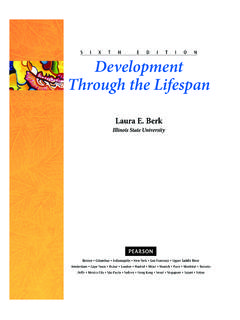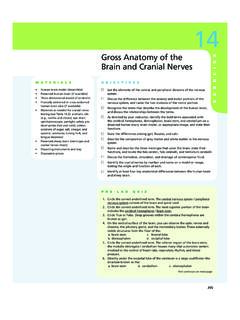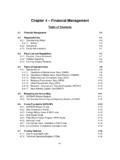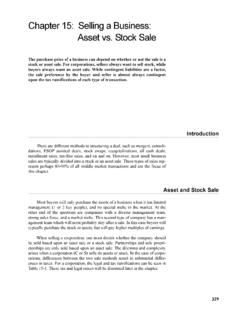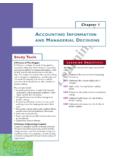Transcription of Organizational Stakeholders, CHAPTER 2 …
1 34 Organizational Stakeholders, management , and EthicsLearning ObjectivesCHAPTER 2P A R T IThe Organization and Its EnvironmentBusiness and ser vice organizations exist to create valued goods and ser vices that people need or may have either a profit or nonprofit orientation for the creation of these goods or ser who decides which particular goods and ser vices an organization should provide, and how do you dividethe value that an organization creates among different groups of people such as management , employees,customers, shareholders, and other stakeholders? If people primarily behave self-interestedly, what mecha-nisms or procedures govern the way an organization uses its resources, and what is to stop the differentgroups within the organization from tr ying to maximize their own share of the value created, possibly at thedetriment or expense of others?
2 At a time when the issue of corporate ethics and management dishonestyand greed has come under intense scrutiny, these questions must be addressed before the issue of design-ing an organization to increase its effectiveness can be studying this CHAPTER you should be able the various stakeholder groups and theirinterests or claims on an organization, its activi-ties, and its created the choices and problems inherentin apportioning and distributing the value anorganization who has authority and responsibilitywithin an organization, and distinguish betweendifferent levels of the agency problem that exists in allauthority relationships and the various mecha-nisms, such as the board of directors andstock options, that can be used to align man-agerial behaviour with Organizational goals orto help control illegal and unethical the vital role played by ethics in STAKEHOLDERSO rganizations exist because of their ability to create valued goods and services andwhich yield acceptable outcomes for various groups of stakeholders, people who havean interest, claim, or stake in the organization, in what it does, and in how well it general, stakeholders are motivated to participate in an organization if theyreceive inducements that exceed the value of the contributions they are required toStakeholders-People, groups or otherorganizations who havean interest, claim.
3 Orstake in an organization,in what it does, and inhow well it per Inducementsare rewards such as money, power, the support of beliefs or values,and Organizational status. Contributionsare the skills, knowledge, and expertise thatorganizations require of their members during task are two main groups of Organizational stakeholders: inside stakeholdersand outside stakeholders. The inducements and contributions of each group are sum-marized in Table StakeholdersInside stakeholders are people who are closest to an organization and have thestrongest or most direct claim on Organizational resources: shareholders, managerialemployees, and nonmanagerial are the owners of the organization, and, as such, theirclaim on Organizational resources is often considered superior to the claims of otherinside stakeholders.
4 The shareholders contribution to the organization is to investmoney in it by buying the organization s shares or stock. The shareholders induce-ment to invest is the prospective money they can earn on their investment in the formof dividends and increases in the price of the stock they have purchased. Investment instock is risky, however, because there is no guarantee of a return. Shareholders who donot believe that the inducement (the possible return on their investment) is enoughto warrant their contribution (the money they have invested) sell their shares andwithdraw their support from the organization. As the following example illustrates,more and more shareholders are relying on large institutional investment companiesto protect their interests and to increase their collective power to influence the activi-ties of organizations.
5 (See Organizational Insight )Managerial EmployeesManagers are the employees who are responsible for coordi-nating Organizational resources and ensuring that an organization s goals are success-fully met. Senior managers are responsible for investing shareholder money in variousCHAPTER 2 Organizational Stakeholders, management , and Ethics35 Inducements-Rewards such asmoney, power, personalaccomplishment, andorganizational skills, knowledge,and expertise that orga-nizations require oftheir members duringtask per to the OrganizationInducement to ContributeInsideShareholdersMoney and capitalDividends and stock appreciationManagersSkills and expertiseSalaries, bonuses, status, and powerWorkforceSkills and expertiseWages, bonuses, stable employment.
6 And promotionOutsideCustomersRevenue from purchase of Quality and price of goods and servicesgoods and servicesSuppliersHigh-quality inputsRevenue from purchase of inputsGovernmentRules governing good business practiceFair and free competitionUnionsFree and fair collective bargainingEquitable share of inducementsCommunitySocial and economic infrastructureRevenue, taxes, employment, quality of life,and concern for the environmentGeneral publicCustomer loyalty and reputationNational prideTable 2-1 INDUCEMENTS AND CONTRIBUTIONS OF Organizational STAKEHOLDERS36 PART IThe Organization and Its EnvironmentORGANIZATIONAL INSIGHT high-profile corporate scandals of WorldCom,Enron, Adelphia, Global Crossing, and others inthe United States, and Nortel Networks in Canadahave sparked significant discussion in investor, gov-ernment, media, and academic circles about theneed for change to corporate governance stan-dards and United States government has opted for aregulative approach.
7 On July 8, 2002, PresidentGeorge W. Bush introduced the Sarbanes-Oxley Act,which is intended to make corporate executives andtheir audit firms more accountable and responsibleto shareholders. Canadian politicians are facingpressure to introduce similar legislation and arestudying various options. In the meantime, though,one very important stakeholder group institutionalinvestors is using its power to influence the gover-nance practices of Canadian Canadian Coalition for Good Governance(CCGG) is a group comprised of some 33 institu-tional investors. Between them, CCGG membersmanage $500 billion in assets. The Ontario TeachersPension Plan and OMERS are among the CCGG sbiggest members, managing the pension plan assetsof Ontario s 252 000 public school teachers and342 000 municipal government CCGG formed in the spring of 2003 with anobjective to jointly promote good governance prac-tices and increased Organizational performance inpublicly traded Canadian companies.
8 In very specificterms, the CCGG wants corporate boards to achievea delicate balance between giving their managementteams the freedom and incentive to pursue perfor-mance goals, while at the same time ensuring thereare appropriate financial, legal, and ethical controlsystems in place. The group describes its approach asbeing able to walk softly and carry a big stick. Bythat, the CCGG means it does much of its workbehind the scenes away from the media their own in-house financial analysts,institutional investors closely monitor and assess thefinancial performance and governance practices ofthe firms whose shares they own. Because of the sizeof their investments in many Canadian public com-panies and because of the negative impact they dhave on these share prices if they sold them sud-denly institutional investors also command a lot ofattention.
9 If they have a concern, they are morelikely to be able to meet with company executivesand directors to discuss the issue and possible reso-lutions. Until the CCGG was formed, suchexchanges were occurring between institutionalinvestors and individual companies, but now theefforts are more coordinated and will most likelyhave greater impact. If desired improvements aren tforthcoming, the CCGG and its members have saidthey will use the stick that is, they will speak pub-licly about their concerns. They may even go so faras to use their shareholder voting power to group is also working to raise the overallgeneral awareness and understanding of corporategovernance issues, making speeches before profes-sional associations, business conferences, and educa-tional forms.
10 The CCGG is using the media and itsown Web site to make people aware of the state ofcorporate governance in Canada and promotes gov-ernance standards and best practices. It is also pub-lishing data collected by other groups, such as theRotman School of management s report card onCanadian governance impact will the CCGG have? It s hard tosay, since the group is still in its infancy. The CCGGhas set a big task for itself in trying to align the inter-ests of boards and management with those of share-holders, but it is an extremely important one. Andwith its financial clout, the CCGG will be a force dif-ficult to Increasing Power of Institutional Investors4resources in order to maximize the future value of goods and services.





